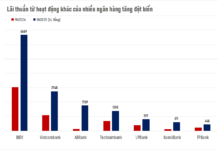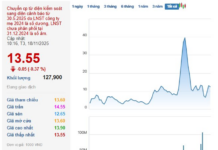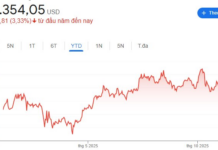On March 5, PV GAS announced that it will officially start supplying LNG (Liquefied Natural Gas) for industrial production from March 15. PV GAS is the first company in Vietnam to distribute LNG for industrial production.

The Thị Vải LNG depot is the first and largest LNG storage facility in Vietnam, located in the Cái Mép Industrial Zone, Bà Rịa – Vũng Tàu Province. (Photo: B.L)
Compared to natural gas, LNG is more abundant and requires fewer fuel supplements. Most importantly, LNG is environmentally friendly. This type of gas is widely used in many developed countries such as the UK, the US, and Japan.
In the future, LNG promises strong development in many countries, including Vietnam. LNG is an important energy source of the future, the main energy source of clean industry.
LNG is widely used in industrial sectors such as power plants and industrial zones. It is also used as fuel for transportation sectors such as cars, ships, trains, and heavy transport vehicles.
Moreover, LNG is also used as a clean energy source for households in remote areas, islands, and coastal areas.
However, to exploit and use LNG, countries have to invest a considerable amount of money in infrastructure, machinery, and transportation. This has made many LNG-developing countries rather cautious.
In an interview with VTC News, Mr. Phạm Văn Phong, General Director of PV GAS, stated that LNG has superior advantages in energy efficiency, environmental friendliness, and convenience in transportation.
According to Mr. Phong, distributing LNG by tank trucks, ships, and trains will ensure a continuous, efficient, and high-performance energy supply chain for partners of the company.
”
PV GAS has completed the 1 million-ton LNG Storage project in Thị Vải since July 2023 and is the only company at the present time to be granted a Certificate of Eligibility for export and import of LNG in Vietnam by the Ministry of Industry and Trade,”
Mr. Phong said.
In the coming time, PV GAS will start the second phase of the Thị Vải LNG Storage with a capacity increased to 3 million tons per year, expected to be operational in 2026. The company is also implementing the Sơn Mỹ LNG central storage port project in Bình Thuận province with a total capacity of 6 million tons per year, as well as other LNG central storage port investment projects in the North Central and North regions.
Mr. Phong shared that PV GAS will also establish agreements with leading LNG suppliers in the world to ensure a stable supply source and competitive prices for the domestic market.
In 2023, PV GAS achieved a revenue of 116,000 billion VND, equivalent to more than 10% of the revenue of the Vietnam Oil and Gas Group (PVN). Pre-tax profit reached over 14,400 billion VND, equal to 177% of the plan, contributing more than 6,200 billion VND to the state budget. In 2023, PV GAS’s LPG sales volume reached nearly 2.5 million tons, an increase of 20% compared to 2022, accounting for 70% of the domestic LPG market share.
Where does LNG come from?
Miners will extract natural gas from offshore mines. This gas will be transported to land and processed at specialized gas treatment systems with deep refrigeration technology at a temperature of -162°C (-260°F). This process will create LNG. The volume of LNG decreases 600 times compared to its gaseous state and has a capacity 2.4 times higher than CNG (compressed natural gas). This makes it easier and cheaper to store and transport LNG vehicles.
LNG is the cleanest gas with the fewest emissions when burned, mostly clean waste. LNG is considered as a global energy substitute for the present and the future.



































